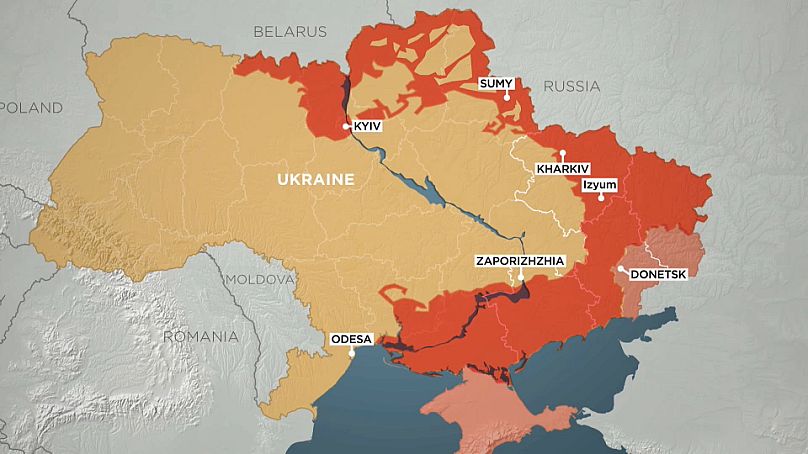Since the beginning of the war, at least 758 civilians have died in Ukraine due to explosions caused by mines.
Long after the fighting has ended, a well-hidden enemy will continue to claim victims in Ukraine: mines.
They are present in nearly a third of the territory and have caused at least 700 civilian casualties since the war began. The Ukrainian government estimates that it will take decades and billions of euros to get rid of them entirely.
"There can be no peace as long as a child can die from a Russian landmine," says Ukrainian President Volodymyr Zelenskyy in his address to the parliament of New Zealand.
Ukraine has become one of the most mine-infested territories in the world. The country's government estimates that at least one-third of its territory, or about 180,000 km2, is contaminated. This area is concentrated in the east and south of the country.
On average, a deminer can secure an area of 10 square meters per day
Securing an area is done in several steps. First, the likelihood of mines or explosive residue being present is assessed by interviewing the owners of the area and the neighbours. If the presence of explosive materials is confirmed, then the Ukrainian emergency services intervene. The deminers will detect the location of the mines, evacuate them if possible, and otherwise destroy them on the spot.
On average, a deminer can secure an area of 10 square meters per day. Quoted by the Japan International Cooperation Agency, Ukrainian emergency services have reportedly said they have the capacity to clear 50 hectares per day or half a square kilometre.
This can be even slower in urban areas like Kyiv. "In a damaged building, it's not like in an open area. Objects can be high up. It is also difficult to identify objects if they have been covered with rubble. The use of metal detectors is also more complicated," explains Aleksandr Lobov. The deminers have to analyse layer after layer of debris, to make sure the place is safe.
De-mining the entire territory will take decades, and will cost at least €364 million per year, the Ukrainian government has already announced.
The United States has already pledged $91 million (€82 million) for demining and prevention efforts. The European Union, meanwhile, will deploy €25 million for this purpose.
Other countries, such as Cambodia, Japan, Belgium, Germany and the Netherlands, have pledged to send specialised equipment and train Ukrainian deminers. The British Minister of Defence, Ben Wallace, has pledged to provide 1,000 metal detectors to Ukraine.
Mines are already hurting civilians
Serghii, 69, and his wife Luba, 66, were walking in the forest near their home in Myla, west of Kyiv. Serghii went a few metres away to look for mushrooms when he heard an explosion and the scream of his wife. He provided her with first aid and called for help. But the forest was deemed too dangerous for an ambulance to pass. Luba died of her injuries on the way to the hospital. This story told on the website of the Halo Trust Foundation, one of the country's leading demining associations, has become commonplace in towns and villages that have seen fighting.
On the regional Telegram feeds of the Ukrainian emergency rescue service, stories of tractors running over anti-tank mines, or people injured by landmines are almost daily. Each time the reminders are the same, summarised in three sentences:
- Do not drive on roads not checked by the deminers.
- Do not go into forests, plains or open spaces, especially if they were under enemy occupation or if battles took place there.
- If you find a suspicious object contact the emergency services by calling 101.
Since the war began, at least 758 people have died in Ukraine as a result of these explosions. One in eight victims was a child, according to NGO Save the Children.
For the moment, the priority of the demining services is to clear the cities and the main roads, but the fields and forests are largely at risk. But some of the population, such as farmers, or those who have lost their jobs because of the war, depending on mushroom picking or fishing for a living.
"We face a dilemma. Many people do not have many options at the moment, to survive. Recalls Aleksandr Lobov, at the risk of their lives, they will start planting, they will go to the forest, to fish or whatever. So the most important thing for us, and for all the organizations that fight against mines, is to raise awareness among the population".












